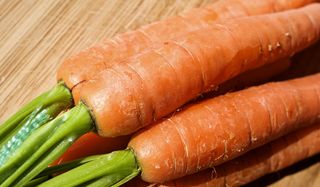Produce From Urban Gardens Could Contain Lead

Urban food gardens offer a great source of affordable, nutritious fruits and veggies for city dwellers, but high levels of toxic metals in soil, especially lead, could pose health risks for people who grow or eat the produce, according to some scientists.
"In places where the soil is heavily contaminated, urban food production may raise as many public health concerns as it solves," said Samantha Langley-Turbaugh, a soil scientist at the University of Southern Maine in Portland. Langley-Turnbaugh discussed the risks associated with growing produce in contaminated soil at the annual conference of the American Association for the Advancement of Science (AAAS) in Boston earlier this month.
Toxic metals, such as lead, zinc and cadmium, are commonly found in soil, particularly in urban areas. And lead is neurotoxic, especially to babies and young children. Previous studies have linked lead to cognitive and developmental delays, lower IQs, violent behavior and health problems, such as high blood pressure. As in the case with lead, exposure to cadmium may lead to learning disabilities, while too much zinc can cause nausea, diarrhea and anemia.
However, the bulk of the research on toxic metals has focused on lead, since lead poisoning is the number one environmental threat to children in the United States.
Sources of lead in soil include past industrial activities, flaking lead paint from old houses, and emissions from leaded gasoline. Though the United States phased out leaded gasoline in cars and trucks during the 1970s and 1980s, soil in high-traffic and urban areas may still contain high levels of the metal.
Some plants can take up lead in contaminated soil through their root systems. Root vegetables and tubers, such as carrots, potatoes and turnips, usually have the highest lead concentrations. Leafy greens, such as spinach, also have high concentrations, according to Langley-Turnbaugh. Fruit-bearing plants, such as tomatoes, strawberries and squash, tend to contain lower lead concentrations.
Few studies have examined the quantity of lead-contaminated produce a person would need to eat in order to raise levels of lead in the blood. It could be highly variable depending on the initial lead concentration in the soil, the type of plant, how much a person eats and his or her body weight, said Langley-Turnbaugh. "It would also depend on a person's nutritional status. The body often retains more lead if it is deficient in calcium," she said.
Sign up for the Live Science daily newsletter now
Get the world’s most fascinating discoveries delivered straight to your inbox.
The total tolerable intake of lead for a child 5 years old or younger is 6 micrograms per day. To put that in perspective, a packet of artificial sweetener usually contains 1 gram of sweetener. Six micrograms is equal to six-millionths of the content of that packet, so not all that much.
"It is easy for a child to obtain more than 6 micrograms of lead per day in a contaminated environment," said Howard Mielke, a toxicologist at Tulane University in New Orleans, who also spoke at the AAAS conference.
Contact with the soil itself may pose an even greater concern than eating contaminated vegetables, said Mielke. When urban gardeners dig in the soil, they can stir up dust from the garden and inhale the lead particles it contains. And children who play in soil can ingest lead when they put their fingers in their mouths. Previous studies have correlated high levels of lead in the soil of urban yards with high levels of the metal in children's blood, according to Langley-Turnbaugh.
"We don’t want to discourage people from gardening or eating produce grown in urban areas, but we do want to suggest some precautions," said Kim Dietrich, an environmental health scientist at the University of Cincinnati School of Medicine, who did not present at the conference.
Adults and children, for instance, should wear gloves while gardening, and take them off before going inside, said Dietrich. Also, it's important to wash produce thoroughly before eating it to make sure no soil remains on the food, added Mielke.
Urban gardeners can also take steps to separate their crops from lead contamination. Planting produce in raised beds with store-bought soil will keep plant roots from coming into contact with contaminated earth.
Because lead travels more readily into the roots of plants when soil conditions are acidic, increasing the alkalinity of the soil may halt the plant's absorption of lead. Adding lime to the soil may raise the pH, making the soil more alkaline or basic.
Houses built before 1978 likely contain lead paint. Even if the house has been remediated and there is no longer a danger from lead paint inside the home, flakes and chips of old paint may remain in the soil around the foundation of the house. Dietrich recommends situating gardens away from the base of the house and away from roadways, where lead levels may be highest.
Before planting a food garden, Langley-Turnbaugh recommends testing the soil for contamination. Most states offer low-cost soil testing through their agricultural cooperative extensions. In her home state of Maine, Langley-Turnbaugh said testing soil for one heavy metal costs about $25 per sample.
Pass it on: Soil in urban gardens may be contaminated with toxic metals, especially lead.
This story was provided by MyHealthNewsDaily, a sister site to LiveScience. Follow MyHealthNewsDaily on Twitter @MyHealth_MHND. We're also on Facebook & Google+.
Most Popular


